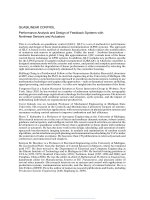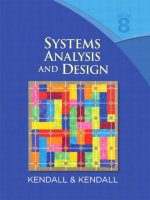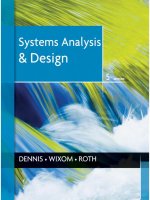linear control system analysis and design fifth edition
Bạn đang xem bản rút gọn của tài liệu. Xem và tải ngay bản đầy đủ của tài liệu tại đây (6.65 MB, 822 trang )
LINEAR CONTROL
SYSTEM ANALYSIS
AND
DESIGN
WITH
MATLAE
Fifth Edition, Revised and Expanded
John
J.
D’Azzo
and Constantine
H.
Houpis
Air Force Institute
of
Technology
Wright-Patterson Air Force Base,
Ohio,
U.S.A.
Stuart
N.
Sheldon
US.
Nuclear Regulatory Commission
Lisle,
Illinois,
U.S.A.
MARCEL
MARCEL
DEKKER,
INC.
9%
DEKKER
NEW
YORK
BASEL
Copyright © 2003 Marcel Dekker, Inc.
ThefourtheditionwaspublishedasLinearControlSystemAnalysisandDesign:
ConventionalandModern,byJohnJ.D’AzzoandConstantineH.Houpis(McGraw-Hill,
1995).
Althoughgreatcarehasbeentakentoprovideaccurateandcurrentinformation,neither
theauthor(s)northepublisher,noranyoneelseassociatedwiththispublication,shallbe
liableforanyloss,damage,orliabilitydirectlyorindirectlycausedorallegedtobecaused
bythisbook.Thematerialcontainedhereinisnotintendedtoprovidespecificadviceor
recommendationsforanyspecificsituation.
Trademarknotice:Productorcorporatenamesmaybetrademarksorregisteredtrade-
marksandareusedonlyforidentificationandexplanationwithoutintenttoinfringe.
LibraryofCongressCataloging-in-PublicationData
AcatalogrecordforthisbookisavailablefromtheLibraryofCongress.
ISBN:0-8247-4038-6
Thisbookisprintedonacid-freepaper.
Headquarters
MarcelDekker,Inc.,270MadisonAvenue,NewYork,NY10016,U.S.A.
tel:212-696-9000;fax:212-685-4540
DistributionandCustomerService
MarcelDekker,Inc.,CimarronRoad,Monticello,NewYork12701,U.S.A.
tel:800-228-1160;fax:845-796-1772
EasternHemisphereDistribution
MarcelDekkerAG,Hutgasse4,Postfach812,CH-4001Basel,Switzerland
tel:41-61-260-6300;fax:41-61-260-6333
WorldWideWeb
The publisher offers discounts on this book w hen ordered in bulk quantities. For more
information, write to Special Sales/Professional Marketing at the headquarters address
above.
Copyright ß 2003 by Marcel Dekker, Inc. Ali Rights Reserved.
N either t his book nor any part may be reproduced or transmitted in any form or by any
means, electronic or m ec hanical, including photocopying, m i crofilming, and recording,
or by any informa tion storage and retrieval system, without permis sion in writing fr om
the publisher.
Current printing (last digit):
10987654321
PRINTED IN UNITED STATES OF AMERICA
Copyright © 2003 Marcel Dekker, Inc.
A
Series of Reference
Books
and
Textbooks
I.
2.
3.
4.
5.
6.
7.
a.
9.
10.
11.
12.
13.
Editors
NEIL
MUNRO,
PH.D.,
D.Sc.
Professor
Applied Control Engineering
University of Manchester Institute of Science and Technology
Manchester, United Kingdom
FRANK
L.
LEWIS,
PH.D.
Moncrief-O'Donnell Endowed Chair
and Associate Director of Research
Automation
&
Robotics Research Institute
University of Texas, Arlington
Nonlinear Control of Electric Machinery,
Damn
M.
Dawson, Jun Hu,
and Timothy
C.
Burg
Computational Intelligence in Control Engineering,
Robert
E.
King
Quantitative Feedback Theory: Fundamentals and Applications,
Con-
stantine H. Houpis and Steven
J.
Rasmussen
Self-Learning Control of Finite Markov Chains,
A.
S.
Poznyak, K. Najim,
and
E.
Gomez-Ramirez
Robust Control and Filtering for Time-Delay Systems,
Magdi
S.
Mah-
moud
Classical Feedback Control: With MATLAB,
Boris
J.
Luhe
and Paul
J.
Enright
Optimal Control of Singularly Perturbed Linear Systems and
Applications: High-Accuracy Techniques,
Zoran Gajic' and Myo-Taeg
Lim
Engineering System Dynamics: A Unified Graph-Centered Approach,
Forhes T. Brown
Advanced Process Identification and Control,
Enso lkonen and
Kaddour Najim
Modem Control Engineering,
P. N. Paraskevopoulos
Sliding Mode Control in Engineering,
edited by Wilfrid Pwrugueffi and
Jean Pierre Barhot
Actuator Saturation Control,
edited by Vikram Kapila and Karolos M.
Gng oria dis
Nonlinear Control Systems,
Zoran VukiC, Ljubomir KuQaCa, Dali
DonlagiC, Sejid Tesnjak
Copyright © 2003 Marcel Dekker, Inc.
14.
Linear Control System Analysis and Design with MATLAB: Fifth Edition,
Revised and Expanded,
John J.
D’Azzo,
Consfanfine
H.
Houpis,
and
Sfuatt
N.
Sheldon
Additional Volumes in Preparation
Robot Manipulator Control: Theory and Practice, Second Edition, Re-
vised and Expanded,
Frank
L. Lewis,
Damn
M.
Dawson, and Chaouki
T.
Abdallah
Robust Control System Design: Advanced State Space Techniques,
Second Edition, Revised and Expanded,
Chia-Chi
Tsui
Copyright © 2003 Marcel Dekker, Inc.
Series Introduction
Many textbooks have been writt en on control engineeri n g, describing new
techniques for co ntrolling systems, or new and better ways of mathematically
formulating existing methods to solve the ever-increasing complex problems
faced by p racticing engineers. H owever, few of these books fully addres s the
applications aspects of control engineering. It is the intention of this new series
to redress this situation.
The series will stress applications issues, and not just the mathematics of
control engineeri ng . It will provi de texts that present not onl y both new and
well-established techniques, bu t also detailed examples of the application of
these methods to the solution of real-world problems. The authors will be drawn
from both the academic world and the relevant applications sectors.
There are already many exciting examples of the application of control
techniques in the established fie l ds of electrical , mechani cal (including aero-
space), and chemical engineering.We have only to look around in today’s highly
automated soci ety to see the use o f advanced robotics techniques in the
manufacturing industries; the use of automated control and navigation systems
in air and surface transport systems; the increasing use of intelligent control
systems in the many artifacts available to the domestic consumer market; and
the reliable supply of water, gas, and electrical power to the domestic consumer
and to industry. However, there are currently many challenging problems that
could benefit from wider exposure to the applicability of control methodolo-
gies, and the systematic systems-oriented basis inherent in the application of
control techniques .
Copyright © 2003 Marcel Dekker, Inc.
This series presents books that draw on expertise from both the academic
world and the applications domains, and will be useful not only as academically
recommended course texts but also as handbook s for practit i on ers in many
applications domains. Linear Control System Analysis and De sign wi th MATLAB
is another outstanding entry in Dekker’s Control Engineering series.
Neil Munro
Copyright © 2003 Marcel Dekker, Inc.
Preface
The countless technological advances of the twentieth century require that
future engineering education emphasize bridging the gap between theory and the
real world.This edition has been prepared with particular attention to the needs
of undergraduates, especially those who seek a solid foundation in control
theory as w ell as an ability to bri dge the gap between control theory and its real-
world applications. To help the reader achieve this goal, computer-aided design
accuracy checks (CADAC) are used throughout the text to encourage good
habits of computer literacy. Each CADAC uses fundamental concepts to ensure
the viability of a computer s olution.
This edition has been enhanced as a solid undergraduate and first-year
graduate text; it emphasizes applying control theory fundamentals to both ana-
log and sampled-data single-input single-output (SISO) feedback control sys-
tems. At the same time, the coverage of digital control systems is greatly
expan ded. Extensive referenc e is made to computer -aided design (CAD)
packages to simplify the design process. The result is a comprehensive pre-
sentation of control theory and designöone that has been thoroughly class-
tested, ensuring its value for classroom and se lf-study use.
This book features extensive use of explan a tions, diagrams , calculat i ons,
tables, and symbols. Such mathematical rigor is necessary for design applica-
tions and advanced control work. A solid foundation is built on concepts of
modern control theory as well as those elements of conventional control theory
that are relevant in analysis and design of control systems. The presentation of
various techniques helps the reader understand what A. T. Fuller has called
Copyright © 2003 Marcel Dekker, Inc.
‘‘theenigmaticcontrolsystem.’’Toprovideacoherentdevelopmentofthesub-
ject,weeschewformalproofsandlemmas,insteadusinganorganizationthat
drawstheperceptivestudentsteadilyandsurelytothedemandingtheoryof
multivariablecontrolsystems.Designexamplesareincludedthroughouteach
chaptertoreinforcethestudent’sunderstandingofthematerial.Astudentwho
hasreachedthispointisfullyequippedtoundertakethechallengesofmore
advancedcontroltheories,aspresentedinadvancedcontroltheorytextbooks.
Chapter2setsforththeappropriatedifferentialequationstodescribethe
performanceofphysicalsystems,networks,anddevices.Theblockdiagram,the
transferfunction,andthestatespace(theessentialconceptofmodern
controltheory)arealsointroduced.Theapproachusedforthestatespaceis
thesimultaneousderivationofthestate-vectordifferentialequationwiththe
SISOdifferentialequationforachosenphysicalsystem.Thechapteralsoshows
howtoderivethemathematicaldescriptionofaphysicalsystemusing
LaGrangeequations.
Chapter3presentstheclassicalmethodofsolvingdifferentialequations.
Oncethestate-variableequationhasbeenintroduced,acarefulexplanationof
itssolutionisprovided.Therelationshipofthetransferfunctiontothestate
equationofthesystemispresentedinChapter14.Theimportanceofthestate
transitionmatrixisdescribed,andthestatetransitionequationisderived.
Theideaofeigenvaluesisexplainednext;thistheoryisusedwiththeCayley^
HamiltonandSylvestertheoremstoevaluatethestatetransitionmatrix.
TheearlypartofChapter4presentsacomprehensivedescriptionof
Laplacetransformmethodsandpole-zeromaps.Somefurtheraspectsofmatrix
algebraareintroducedasbackgroundforsolvingthestateequationusing
Laplacetransforms.Finally,theevaluationoftransfermatricesisclearly
explained.
Chapter5beginswithsystemrepresentationbytheconventionalblock-
diagramapproach.Thisisfollowedbyadiscussionofsimulationdiagramsand
thedeterminationofthestatetransitionequationusingsignalflowgraphs.The
chapteralsoexplainshowtoderiveparallelstatediagramsfromsystemtransfer
functions,establishingtheadvantagesofhavingthestateequationinuncoupled
form.
Chapter6introducesbasicfeedbacksystemcharacteristics.Thisincludes
therelationshipbetweensystemtypeandtheabilityofthesystemtofollowor
trackpolynomialinputs.
Chapter7presentsthedetailsoftheroot-locusmethod.Chapters8and9
describethefrequency-responsemethodusingbothlogandpolarplots.These
chaptersaddressthefollowingtopics:theNyquiststabilitycriterion;thecorre-
lationbetweenthes-plane,frequencydomain,andtimedomain;andgainset-
tingtoachieveadesiredoutputresponsepeakvaluewhiletrackingpolynomial
commandinputs.Chapters10and11describethemethodsforimproving
Copyright © 2003 Marcel Dekker, Inc.
systemperformance,includingexamplesofthetechniquesforapplyingcascade
andfeedbackcompensators.Boththeroot-locusandfrequency-response
methodsofdesigningcompensatorsarecovered.
Chapter12developstheconceptofmodelingadesiredcontrolratiowith
figuresofmerittosatisfysystemperformancespecifications.Thesysteminputs
generallyfallintotwocategories:(1)desiredinputthatthesystemoutputisto
track(atrackingsystem)and(2)anexternaldisturbanceinputforwhichthe
systemoutputistobeminimal(adisturbance-rejectionsystem).Forbothtypes
ofsystems,thedesiredcontrolratioissynthesizedbytheproperplacement
ofitspolesandinclusionofzeros,ifrequired.Chapter12alsointroducesthe
Guillemin-Truxaldesignprocedure,whichisusedfordesigningatracking
controlsystemandadesignprocedureemphasizingdisturbancerejection.
Chapter13explainshowtoachievedesiredsystemcharacteristicsusing
completestate-variablefeedback.Twoimportantconceptsofmoderncontrol
theoryöcontrollabilityandobservabilityöaretreatedinasimpleandstraight-
forwardmanner.
Chapter14presentsthesensitivityconceptsofBode,asusedinvariation
ofsystemparameters.Othertoolsincludethemethodofusingfeedbacktransfer
functionstoformestimatesofinaccessiblestatesforuseinstatefeedback,and
atechniqueforlinearizinganonlinearsystemaboutitsequilibriumpoints.
Chapter15presentsthefundamentalsofsampleddata(S-D)control
systems.Chapter16describesthedesignofdigitalcontrolsystems,demonstrat-
ing,forexample,theeffectivenessofdigitalcompensation.Theconceptofa
pseudo-continuous-time(PCT)modelofadigitalsystempermitstheuseof
continuous-timemethodsforthedesignofdigitalcontrolsystems.
Thetexthasbeenpreparedsothatitcanbeusedforself-studyby
engineersinvariousareasofpractice(electrical,aeronautical,mechanical,
etc.).Tomakeitvaluabletoallengineers,weusevariousexamplesoffeedback
controlsystemsandunifythetreatmentofphysicalcontrolsystemsbyusing
mathematicalandblock-diagrammodelscommontoall.
Therearemanycomputer-aideddesign(CAD)packages(e.g.,
MATLAB
Õ
[seeApp.C],Simulink,andTOTAL-PC)availabletohelpstudents
and practicing engineers analyze, design, and simulate control systems. The use
of MATLAB is emphasized throughout the book, and many MATLAB m- fil es
are presented as examples .
We thank the students who have used this book in its previous editions
and the instructors who have reviewed this edition for their helpful comments
and recommendations. We thank especially Dr. R. E. Fontana, Professor
Emeritus of Electrical Engineering, Air Force Institute of Technology, for the
encouragement he provided for the previous editions. This edition is dedicated
to the memory of Dr. T. J. Higgins, Professor Emeritus of Electrical Engineer-
ing,University of Wisconsin, for his thorough review of the earlier manuscripts.
Copyright © 2003 Marcel Dekker, Inc.
We also express our appreciation to Professor Emeritus Donald McLean
of the Univ ersity of Southampton, England, formerly a visiting profes sor at
the Air Force Institute of Technology. Our association wi th him has been an
enlightening and refreshing experience. The personal relationship with him
has been a source of inspiration and deep respect.
John J. D’Azzo
Constantine H. Houpis
Stuart N. She ldon
Copyright © 2003 Marcel Dekker, Inc.
Contents
SeriesIntroductioniii
Prefacev
1Introduction1
1.1Introduction1
1.2IntroductiontoControlSystems2
1.3Definitions12
1.4HistoricalBackground14
1.5DigitalControlDevelopment18
1.6MathematicalBackground20
1.7TheEngineeringControlProblem22
1.8ComputerLiteracy25
1.9OutlineofText26
2WritingSystemEquations31
2.1Introduction31
2.2ElectricCircuitsandComponents33
2.3StateConcepts38
2.4TransferFunctionandBlockDiagram45
2.5MechanicalTranslationSystems45
2.6AnalogousCircuits52
2.7MechanicalRotationalSystems53
ix
Copyright © 2003 Marcel Dekker, Inc.
2.8EffectiveMomentofInertiaandDampingofaGearTrain56
2.9ThermalSystems58
2.10HydraulicLinearActuator61
2.11Liquid-LevelSystem66
2.12RotatingPowerAmplifiers67
2.13DCServomotor69
2.14ACServomotor71
2.15Lagrange’sEquation73
2.16Summary77
3SolutionofDifferentialEquations79
3.1Introduction79
3.2StandardInputstoControlSystems80
3.3Steady-StateResponse:SinusoidalInput81
3.4Steady-StateResponse:PolynomialInput83
3.5TransientResponse:ClassicalMethod85
3.6DefinitionofTimeConstant89
3.7Example:Second-OrderSystemöMechanical90
3.8Example:Second-OrderSystemöElectrical92
3.9Second-OrderTransients94
3.10Time-ResponseSpecifications98
3.11CADAccuracyChecks(CADAC)99
3.12State-VariableEquations100
3.13CharacteristicValues102
3.14EvaluatingtheStateTransitionMatrix103
3.15CompleteSolutionoftheStateEquation106
3.16Summary107
4LaplaceTransform109
4.1Introduction109
4.2DefinitionoftheLaplaceTransform110
4.3DerivationofLaplaceTransformsofSimpleFunctions110
4.4LaplaceTransformTheorems112
4.5CADAccuracyChecks:CADAC115
4.6ApplicationoftheLaplaceTransformto
DifferentialEquations115
4.7InverseTransformation117
4.8HeavisidePartial-FractionExpansionTheorems118
4.9MATLABPartial-FractionExample126
4.10Partial-FractionShortcuts128
4.11GraphicalInterpretationofPartial-FractionCoefficients130
Copyright © 2003 Marcel Dekker, Inc.
4.12FrequencyResponsefromthePole-ZeroDiagram134
4.13LocationofPolesandStability137
4.14LaplaceTransformoftheImpulseFunction138
4.15Second-OrderSystemwithImpulseExcitation141
4.16SolutionofStateEquation142
4.17EvaluationoftheTransfer-FunctionMatrix144
4.18MATLABm-FileforMIMOSystems146
4.19Summary148
5SystemRepresentation 151
5.1Introduction151
5.2BlockDiagrams152
5.3DeterminationoftheOverallTransferFunction156
5.4StandardBlockDiagramTerminology160
5.5PositionControlSystem163
5.6SimulationDiagrams167
5.7SignalFlowGraphs172
5.8StateTransitionSignalFlowGraph178
5.9ParallelStateDiagramsfromTransferFunctions182
5.10DiagonalizingtheAMatrix185
5.11UseofStateTransformationfortheState
EquationSolution197
5.12TransformingaMatrixwithComplexEigenvalues198
5.13TransforminganAMatrixinto
CompanionForm201
5.14UsingMATLABtoObtaintheCompanion
AMatrix204
5.15Summary207
6Control-SystemCharacteristics209
6.1Introduction209
6.2Routh’sStabilityCriterion210
6.3MathematicalandPhysicalForms216
6.4FeedbackSystemTypes218
6.5AnalysisofSystemTypes219
6.6Example:Type2System225
6.7Steady-StateErrorCoefficients227
6.8CADAccuracyChecks:CADAC231
6.9UseofSteady-StateErrorCoefficients232
6.10Nonunity-FeedbackSystem234
6.11Summary235
Copyright © 2003 Marcel Dekker, Inc.
7RootLocus237
7.1Introduction237
7.2PlottingRootsofaCharacteristicEquation238
7.3QualitativeAnalysisoftheRootLocus242
7.4ProcedureOutline244
7.5Open-LoopTransferFunction246
7.6PolesoftheControlRationC(s)/R(s)247
7.7ApplicationoftheMagnitudeandAngleConditions249
7.8GeometricalProperties(ConstructionRules)252
7.9CADAccuracyChecks(CADAC)264
7.10RootLocusExample264
7.11ExampleofSection7.10:MATLABRootLocus268
7.12RootLocusExamplewithanRHPlaneZero272
7.13PerformanceCharacteristics273
7.14TransportLag279
7.15Synthesis280
7.16SummaryofRoot-LocusConstructionRules
forNegativeFeedback282
7.17Summary284
8FrequencyResponse285
8.1Introduction285
8.2CorrelationoftheSinusoidalandTimeResponse286
8.3Frequency-ResponseCurves287
8.4BodePlots(LogarithmicPlots)289
8.5GeneralFrequency-Transfer-FunctionRelationships291
8.6DrawingtheBodePlots292
8.7ExampleofDrawingaBodePlot298
8.8GenerationofMATLABBodePlots301
8.9SystemTypeandGainasRelatedtoLog
MagnitudeCurves302
8.10CADAccuracyChecks(CADAC)305
8.11ExperimentalDeterminationofTransferFunction305
8.12DirectPolarPlots312
8.13Summary:DirectPolarPlots314
8.14Nyquist’sStabilityCriterion315
8.15ExamplesofNyquist’sCriterionUsingDirect
PolarPlot323
8.16Nyquist’sStabilityCriterionAppliedtoSystem
HavingDeadTime327
8.17DefinitionsofPhaseMarginandGainMarginand
TheirRelationtoStability328
Copyright © 2003 Marcel Dekker, Inc.
8.18StabilityCharacteristicsoftheLogMagnitude
andPhaseDiagram331
8.19StabilityfromtheNicholsPlot
(LogMagnitude^AngleDiagram)332
8.20Summary335
9Closed-LoopTrackingPerformanceBasedonthe
FrequencyResponse339
9.1Introduction339
9.2DirectPolarPlot340
9.3DeterminationofM
m
ando
m
foraSimple
Second-OrderSystem341
9.4CorrelationofSinusoidalandTimeResponses345
9.5ConstantM(o)and(o)ContoursofC(jo)/R(jo)on
theComplexPlane(DirectPlot)346
9.6Constant1/MandContours(UnityFeedback)inthe
InversePolarPlane353
9.7GainAdjustmentofaUnity-FeedbackSystemfora
DesiredM
m
:DirectPolarPlot355
9.8ConstantMandCurvesontheLogMagnitude^Angle
Diagram(NicholsChart)358
9.9GenerationofMATLABBodeandNyquistPlots361
9.10AdjustmentofGainbyUseoftheLogMagnitude^Angle
Diagram(NicholsChart)363
9.11CorrelationofPole-ZeroDiagramwithFrequencyand
TimeResponses366
9.12Summary368
10Root-LocusCompensation:Design371
10.1IntroductiontoDesign371
10.2TransientResponse:DominantComplexPoles374
10.3AdditionalSignificantPoles379
10.4Root-LocusDesignConsiderations382
10.5ReshapingtheRootLocus384
10.6CADAccuracyChecks(CADAC)385
10.7IdealIntegralCascadeCompensation(PIController)385
10.8CascadeLagCompensationDesignUsing
PassiveElements386
10.9IdealDerivativeCascadeCompensation
(PDController)391
10.10LeadCompensationDesignUsingPassiveElements393
Copyright © 2003 Marcel Dekker, Inc.
10.11GeneralLead-CompensatorDesign398
10.12Lag-LeadCascadeCompensationDesign400
10.13ComparisonofCascadeCompensators402
10.14PIDController405
10.15IntroductiontoFeedbackCompensation407
10.16FeedbackCompensation:DesignProcedures409
10.17SimplifiedRateFeedbackCompensation:
ADesignApproach410
10.18DesignofRateFeedback412
10.19Design:FeedbackofSecondDerivativeofOutput417
10.20ResultsofFeedbackCompensationDesign419
10.21RateFeedback:PlantswithDominant
ComplexPoles420
10.22Summary421
11Frequency-ResponseCompensationDesign423
11.1IntroductiontoFeedbackCompensationDesign423
11.2SelectionofaCascadeCompensator425
11.3CascadeLagCompensator429
11.4DesignExample:CascadeLagCompensation432
11.5CascadeLeadCompensator436
11.6DesignExample:CascadeLeadCompensation439
11.7CascadeLag-LeadCompensator443
11.8DesignExample:CascadeLag-LeadCompensation445
11.9FeedbackCompensationDesignUsingLogPlots446
11.10DesignExample:FeedbackCompensation(LogPlots)450
11.11ApplicationGuidelines:BasicMinor-Loop
FeedbackCompensators457
11.12Summary458
12Control-RatioModeling461
12.1Introduction461
12.2ModelingaDesiredTrackingControlRatio462
12.3Guillemin-TruxalDesignProcedure467
12.4IntroductiontoDisturbanceRejection469
12.5ASecond-OrderDisturbance-RejectionModel470
12.6Disturbance-RejectionDesignPrinciples
forSISOSystems472
12.7Disturbance-RejectionDesignExample478
12.8Disturbance-RejectionModels481
12.9Summary485
Copyright © 2003 Marcel Dekker, Inc.
13Design:Closed-LoopPole-ZeroAssignment
(State-VariableFeedback)487
13.1Introduction487
13.2ControllabilityandObservability488
13.3StateFeedbackforSISOSystems497
13.4State-FeedbackDesignforSISOSystemsUsing
theControlCanonical(Phase-Variable)Form500
13.5State-VariableFeedback(PhysicalVariables)503
13.6GeneralPropertiesofStateFeedback
(UsingPhaseVariables)507
13.7State-VariableFeedback:Steady-StateErrorAnalysis510
13.8UseofSteady-StateErrorCoefficients513
13.9State-VariableFeedback:All-PolePlant517
13.10PlantswithComplexPoles520
13.11CompensatorContainingaZero522
13.12State-VariableFeedback:Pole-ZeroPlant523
13.13Observers532
13.14ControlSystemsContainingObservers534
13.15Summary536
14ParameterSensitivityandState-SpaceTrajectories539
14.1Introduction539
14.2Sensitivity539
14.3SensitivityAnalysis544
14.4SensitivityAnalysisExamples547
14.5ParameterSensitivityExamples553
14.6InaccessibleStates554
14.7State-SpaceTrajectories558
14.8Linearization(JacobianMatrix)561
14.9Summary565
15Sampled-DataControlSystems567
15.1Introduction567
15.2Sampling568
15.3IdealSampling571
15.4Z-TransformTheorems576
15.5DifferentiationProcess576
15.6SynthesisinthezDomain(DirectMethod)579
15.7TheInverseZTransform585
15.8Zero-OrderHold586
15.9Limitations588
Copyright © 2003 Marcel Dekker, Inc.
15.10Steady-StateErrorAnalysisforStableSystems589
15.11Root-LocusAnalysisforSampled-Data
ControlSystems596
15.12Summary606
16DigitalControlSystems609
16.1Introduction609
16.2ComplementarySpectra610
16.3TustinTransformation:stozPlaneTransformation611
16.4z-Domaintothew-andw
0
-DomainTransformations618
16.5Digitization(DIG)Technique619
16.6Digitization(DIG)DesignTechnique620
16.7ThePseudo-Continuous-Time(PCT)ControlSystem622
16.8DesignofDigitalControlSystem636
16.9Direct(DIR)Compensator636
16.10PCTLeadCascadeCompensation637
16.11PCTLagCompensation643
16.12PCTLag-LeadCompensation648
16.13FeedbackCompensation:Tracking655
16.14ControllingUnwantedDisturbances664
16.15ExtensiveDigitalFeedbackCompensatorExample668
16.16ControllerImplementation670
16.17Summary672
AppendixATableofLaplaceTransformPairs675
AppendixBMatrixLinearAlgebra679
AppendixCIntroductiontoMATLABandSimulink693
AppendixDTOTAL-PCCADPackage711
Problems719
AnswerstoSelectedProblems795
Copyright © 2003 Marcel Dekker, Inc.
1
Introduction
1.1INTRODUCTION
Thetechnologicalexplosionofthetwentiethcentury,whichwasaccelerated
bytheadventofcomputersandcontrolsystems,hasresultedintremendous
advancesinthefieldofscience.Thus,automaticcontrolsystemsand
computerspermeatelifeinalladvancedsocietiestoday.Thesesystemsand
computershaveactedandareactingascatalystsinpromotingprogress
anddevelopment,propellingsocietyintothetwenty-firstcentury.
Technologicaldevelopmentshavemadepossiblehigh-speedbullettrains;
exoticvehiclescapableofexplorationofotherplanetsandouterspace;the
establishmentoftheAlphaspacestation;safe,comfortable,andefficient
automobiles;sophisticatedcivilianandmilitary[manualand
uninhabited(seeFig.1.1)]aircraft;efficientroboticassemblylines;and
efficient environmentally friendly pollution controls for factories. The
successful operation of all of these systems depends on the proper function-
ing of the large number of control systems used in such ventures.
Copyright © 2003 Marcel Dekker, Inc.
1.2INTRODUCTIONTOCONTROLSYSTEMS
ClassicalExamples
ThetoasterinFig.1.2acanbesetforthedesireddarknessofthetoastedbread.
Thesettingofthe‘‘darkness’’knob,ortimer,representstheinputquantity,
andthedegreeofdarknessandcrispnessofthetoastproducedistheoutput
quantity.Ifthedegreeofdarknessisnotsatisfactory,becauseofthecondition
ofthebreadorsomesimilarreason,thisconditioncaninnowayautomati-
callyalterthelengthoftimethatheatisapplied.Sincetheoutputquantity
hasnoinfluenceontheinputquantity,thereisnofeedbackinthissystem.
Theheaterportionofthetoasterrepresentsthedynamicpartoftheoverall
system,andthetimerunitisthereferenceselector.
ThedcshuntmotorofFig.1.2bisanotherexample.Foragivenvalueof
fieldcurrent,arequiredvalueofvoltageisappliedtothearmaturetoproduce
thedesiredvalueofmotorspeed.Inthiscasethemotoristhedynamicpartof
thesystem,theappliedarmaturevoltageistheinputquantity,andthespeed
oftheshaftistheoutputquantity.Avariationofthespeedfromthedesired
value,duetoachangeofmechanicalloadontheshaft,caninnowaycause
achangeinthevalueoftheappliedarmaturevoltagetomaintainthedesired
speed.Therefore,theoutputquantityhasnoinfluenceontheinputquantity.
FIGURE1.1Anunmannedaircraft.
2 Chapter 1
Copyright © 2003 Marcel Dekker, Inc.
Systems in which the output quantity has no effect upon the inp ut
quantity are called open-loop control systems.The examples just cited are repre-
sented symbolically by a functional block diagram, as shown in Fig. 1.2c.In
this figure, (1) the desired darkness of the toast or the desired speed of the
motor is the command input, (2) the selection of the value of time on the
FIGURE 1.2 Open-loop control systems: (a) automatic toaster; (b) electric motor;
(c) functional block diagram.
Introduction 3
Copyright © 2003 Marcel Dekker, Inc.
toastertimerorthevalueofvoltageappliedtothemotorarmatureis
representedbythereference-selectorblock,and(3)theoutputofthisblockis
identifiedasthereferenceinput.Thereferenceinputisappliedtothedynamic
unitthatperformsthedesiredcontrolfunction,andtheoutputofthisblockis
thedesiredoutput.
Apersoncouldbeassignedthetaskofsensingtheactualvalueofthe
outputandcomparingitwiththecommandinput.Iftheoutputdoesnot
havethedesiredvalue,thepersoncanalterthereference-selectorpositionto
achievethisvalue.Introducingthepersonprovidesameansthroughwhich
theoutputisfedbackandiscomparedwiththeinput.Anynecessarychange
isthenmadeinordertocausetheoutputtoequalthedesiredvalue.
Thefeedbackactionthereforecontrolstheinputtothedynamicunit.Systems
inwhichtheoutputhasadirecteffectupontheinputquantityarecalledclosed-
loopcontrolsystems.
Toimprovetheperformanceoftheclosed-loopsystemsothattheoutput
quantityisascloseaspossibletothedesiredquantity,thepersoncanbe
replacedbyamechanical,electrical,orotherformofacomparisonunit.The
functionalblockdiagramofasingle-inputsingle-output(SISO)closed-loopcon-
trolsystemisillustratedinFig.1.3.Comparisonbetweenthereferenceinput
andthefeedbacksignalsresultsinanactuatingsignalthatisthe
differencebetweenthesetwoquantities.Theactuatingsignalactstomaintain
theoutputatthedesiredvalue.Thissystemiscalledaclosed-loopcontrol
system.Thedesignationclosed-loopimpliestheactionresultingfromthe
comparisonbetweentheoutputandinputquantitiesinordertomaintainthe
outputatthedesiredvalue.Thus,theoutputiscontrolledinordertoachieve
thedesiredvalue.
Examplesofclosed-loopcontrolsystemsareillustratedinFigs.1.4and
1.5.Inahomeheatingsystemthedesiredroomtemperature(commandinput)
FIGURE 1.3 Functional block diagram of a closed-loop system.
4 Chapter 1
Copyright © 2003 Marcel Dekker, Inc.
issetonthethermostatinFig.1.4.(referenceselector).Abimetalliccoilinthe
thermostatisaffectedbyboththeactualroomtemperature(output)andthe
reference-selectorsetting.Iftheroomtemperatureislowerthanthedesired
temperature,thecoilstripaltersitsshapeandcausesamercuryswitchto
operatearelay,whichturnsonthefurnacetoproduceheatintheroom.
Whentheroomtemperature[1]reachesthedesiredtemperature,theshapeof
thecoilstripisagainalteredsothatthemercuryswitchopens.Thisdeactivates
therelayandinturnshutsoffthefurnace.Inthisexample,thebimetalliccoil
performsthefunctionofacomparatorsincetheoutput(roomtemperature)
isfedbackdirectlytothecomparator.Theswitch,relay,andfurnacearethe
dynamicelementsofthisclosed-loopcontrolsystem.
Aclosed-loopcontrolsystemofgreatimportancetoallmultistorybuild-
ingsistheautomaticelevatorofFig.1.5.Apersonintheelevatorpressesthe
buttoncorrespondingtothedesiredfloor.Thisproducesanactuatingsignal
thatindicatesthedesiredfloorandturnsonthemotorthatraisesorlowersthe
elevator.Astheelevatorapproachesthedesiredfloor,theactuatingsignal
decreasesinvalueand,withtheproperswitchingsequences,theelevator
stopsatthedesiredfloorandtheactuatingsignalisresettozero.Theclosed-
loopcontrolsystemfortheexpresselevatorintheSearsTowerbuildingin
Chicagoisdesignedsothatitascendsordescendsthe103floorsinjust
under1minwithmaximumpassengercomfort.
ModernExamples
Theexamplesinthissectionrepresentcomplexclosed-loopcontrolsystems
thatareattheforefrontoftheapplicationofcontroltheorytothecontrol
systemchallengesofthetwenty-firstcentury.
Theultimateobjectiveinroboticarmcontrolresearch[2]*istoprovide
humanarmemulation.Payloadinvarianceisanecessarycomponentof
*Referencesareindicatedbynumbersinbracketsandarefoundattheendofthechapter.
FIGURE1.4Homeheatingcontrolsystem.
Introduction 5
Copyright © 2003 Marcel Dekker, Inc.
humanarmemulation.Model-basedcontrollersrequireaccurateknowledge
ofpayloadanddrivesystemdynamicstoprovidegoodhigh-speedtracking
accuracy.Arobustmultivariablecontrolsystemdesigntechniqueisrequired
whichsolvesthepayloadanddynamicsuncertainty.Thus,themodel-based
quantitativefeedbacktheory(QFT)designtechnique[3]isappliedwhich
resultsincontrollersthatareimplementedbyaseriesofsimplebackwards
differenceequations.QFThigh-speedtrackingaccuracywasexperimentally
evaluatedonthefirstthreelinksofthePUMA-500ofFig.1.6.Thisrobust
designtechniqueincreasedtrackingaccuracybyuptoafactorof4overthe
model-basedcontrollerperformancebaseline.TheQFTtrackingperfor-
manceisrobustforbothunmodeleddrivesystemdynamicsandpayload
uncertainty.ThenonheuristicnatureoftheQFTdesignandtuningshould
allowapplicationtoawiderangeofmanipulators.
Theinterestinimprovingthefuelefficiencyofautomobileshasspurred
theimprovementoftheidlespeedcontrolfortheautomotivefuel-injected
engine[4,5].Thefollowingistheabstractfromthepaperentitled‘‘Robust
ControllerDesignandExperimentalVerificationofI.C.EngineSpeed
Control’’byG.K.HamiltonandM.A.Franchek,SchoolofMechanical
Engineering,PurdueUniversity[4].
FIGURE1.5Automaticelevator.
6 Chapter 1
Copyright © 2003 Marcel Dekker, Inc.
Presented in this paper is the robust idle speed control of a Ford 4.6L
V-8 fuel injected engine. The goal of this investigation is to design
a robust feedback controller that maintains the idle speed within
a 150 rp m tolerance of abou t 600 rpm despite a 20 Nm step torque
disturbance delivered by the power steering pump. The controlled
input is the by-pass air valve which is subjected to an output satura-
tion constraint. Issues complicating the controller design include the
nonlinear nature of the engine dynamics, the induction-to-power
delay of the manifold filling dynamics, and the saturation constr aint
of the by-pass air valve. An experimental verification of the proposed
controller, utilizing the nonlinear pla nt, is included.
FIGURE 1.6 Robot arm (From Ref. 2).
Introduction 7
Copyright © 2003 Marcel Dekker, Inc.









